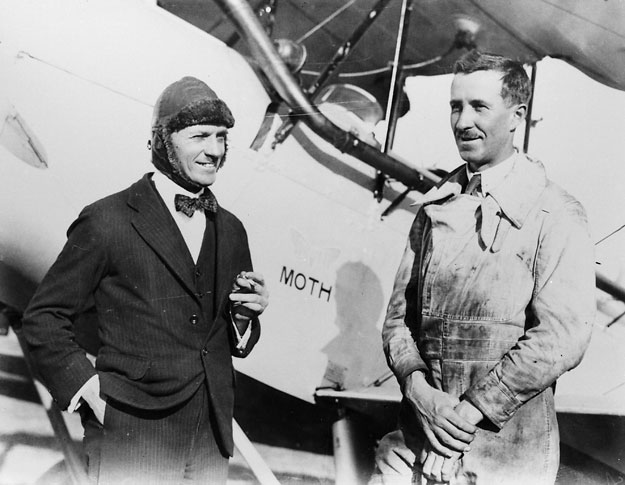
Captain
Frank William Follett (right, in the photo above) was appointed the
first Superintendent of Aircraft in the newly-formed Civil
Aviation Branch (CAB) of the Department of Defence on 2 February
1921. As such, he was responsible for the inspection and airworthiness
of Australian aircraft, the licensing of engineers and flight-testing
of new aircraft models.
In December 1922 examinations commenced for the licensing of engineers, who were able to qualify in four categories:
-
Division A - aircraft construction for periodic overhaul
-
Division B - aircraft construction and testing after periodic overhaul
-
Division C - testing and rigging for flight
-
Division D - preparation of aircraft engines and installation for flight
At Richmond, New South Wales, in December 1924, during Australia's first flying week for testing low-powered aircraft, Follett flew several Departmental aeroplanes. He gained the highest number of points in the trials in a DH53 (but failed to beat Bert Hinkler's mileage record), and won the Aerial Derby in DH37 G-AUAA.
Frank Follett had been born to English immigrant parents on 27 March 1892 in the Sydney suburb of Marrickville. After schooling, he joined the firm of Simpson Bros, engineers, in Sydney, and then in May 1910 joined the engineering department of the Metropolitan Board of Water Supply and Sewerage as a cadet draftsman. By 1916 he had risen to the position of compiling draftsman.
Like
many young men of his age, Frank Follett enlisted in the Australian
Imperial Force in January 1916. He saw active service in France with
the Australian Field Engineers and was later promoted sergeant and assistant
technical warrant officer. Re-mustering to the Australian Flying Corps
(AFC), he trained as a pilot with 29 Squadron at
Fern Hill, England. On completion of training he was commissioned Second
Lieutenant on 18 November 1917.
Posted to France with 2 Squadron at Reclinghem (in the Pas de Calais) on S.E.5s, Frank Follett saw much action in July 1918 harassing the enemy over the Lys in poor flying conditions. The Official History of Australia in the War of 1914-1918 describes one action thus: "Lieutenant F.W. Follett, who had singled out the rearmost Fokker, fired sixty rounds into it at almost touching distance and sent it down in a cloud of black smoke." The Officer Commanding 2 Squadron at this time was Major A. Murray Jones, later the CAB's second Superintendent of Flying Operations.
Returning to Australia in June 1919, Frank Follett resumed his pre-war job. However, the lure of aviation drew him to the position at the CAB.
He resigned from the Defence Department in June 1929, and from July 1929 to August 1930 was manager and chief instructor of the (Royal) Aero Club of New South Wales at Mascot.
In 1930 Frank Follett and H.T. (Bunny) Hammond founded Adastra Airways Pty Ltd which, although beginning as a flying school, came to specialise in aerial surveying. In 1933, Frank Follett had become interested in aerial survey but most of the survey work at that time was carried out by the RAAF. Follett approached his former colleagues at the CAB about the participation of the private sector in this government work. Follett's approach prompted the Controller of Civil Aviation, Captain E.C. Johnston DFC, to make a submission resulting in the Minister for Defence authorising the appointment of an Air Survey Committee.
The following year the Committee recommended that civil aviation companies confine their work to commercial contracts and that government work should be done by an official agency, preferably the RAAF. One member of the Committee, CAB Superintendent of Aerodromes A.R. McComb, dissented with this recommendation. In his opinion, there was some difficulty in training air force crews for survey flying, which was quite different from wartime flying, and RAAF work should be confined to servicing army requirements. He felt that commercial companies should be encouraged. Johnston agreed in principle with McComb.
In 1939, aware of the enormous potential in Australia and the lag in Australia's aerial mapping programme, Frank Follett studied the latest techniques in England, the Netherlands, Switzerland and Germany, arriving home just before the outbreak of the Second World War.
During the war, Adastra was the only private company able to take part in an emergency program to map Australia. The Chief Pilot at this time was Norman Rodoni, later to become a DCA Flight Checking Officer. After the war the firm expanded. By 1949 it had the most sophisticated stereo-plotting equipment in Australia and received large government contracts including an 8000-square mile (21,000 square km) survey of the entire Darling River.
Quiet, retiring and somewhat dour, Frank Follett played a leading part in the development of aerial surveying and photogrammetry. His other interests included tennis, boating, growing orchids and Legacy. He was a member of the Imperial Service Club of New South Wales and of the Royal Society of Arts, London. In 1935 he received the silver medal of the Royal Humane and Shipwreck Society.
Frank Follett died of heart disease outside his Vaucluse home on 25 October 1950. He was survived by his wife; a daughter had predeceased him.
(With acknowledgement to Ron Cuskelly, John McCarthy and the Australian
Dictionary of Biography, Volume 8, for much of this biography.)
(Photo: CAHS collection)
Back to the main Departmental People index
If this page appears without a menu bar at top and left, click here